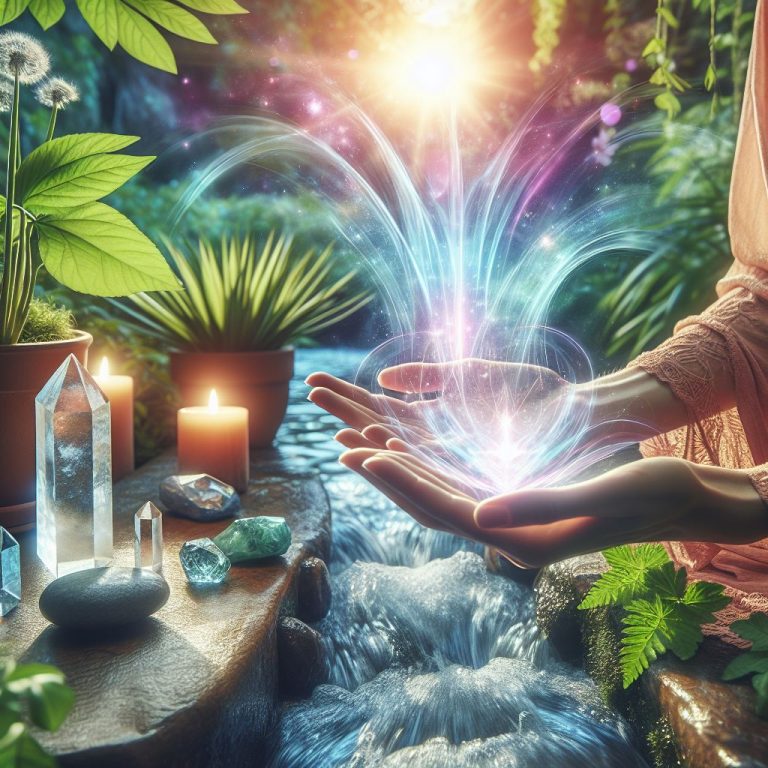Is Energy Healing Real? The Science Behind Chakras & Ancient Traditions

Key Takeaways
- Energy healing is based on the belief that the body can heal itself through manipulating energy fields.
- Chakras are considered energy centers in the body that influence physical and emotional well-being.
- Scientific research on energy healing is limited and often inconclusive, but some studies suggest potential benefits.
- Ancient traditions such as Reiki and acupuncture have been practiced for centuries and are still popular today.
- While some people report positive effects, energy healing should complement, not replace, conventional medical treatments.
Exploring Energy Healing and Its Roots
Energy healing has intrigued people for centuries, promising an alternative path to wellness. It is grounded in the belief that the body has the innate ability to heal itself through the manipulation of energy fields. This concept, while ancient, continues to resonate with many seeking holistic health solutions.
But what exactly is energy healing? At its core, energy healing is about restoring balance to the body’s energy systems. This balance is thought to be crucial for maintaining physical, emotional, and spiritual health. Various techniques, from Reiki to acupuncture, aim to unblock or redirect energy flows, promoting healing and well-being.
What is Energy Healing?
Energy healing encompasses a range of practices that focus on the body’s energy fields. These fields, sometimes called “life force” or “prana,” are believed to influence our health and vitality. Practitioners use different methods to manipulate these energies, helping the body heal itself. Techniques can include hands-on practices like Reiki or non-contact methods such as distant healing.
Reiki, for instance, involves the practitioner placing their hands lightly on or near the recipient’s body to facilitate energy flow. This practice is rooted in Japanese tradition and is widely used today to promote relaxation and reduce stress.
Importance and Popularity in Modern Times
In our fast-paced world, many people are turning to energy healing for its promise of holistic wellness. Its popularity can be attributed to a growing interest in alternative and complementary medicine. People are seeking ways to manage stress, alleviate pain, and improve their overall quality of life without relying solely on pharmaceuticals.
Furthermore, energy healing often emphasizes the connection between mind, body, and spirit, offering a more integrated approach to health. This holistic perspective appeals to those looking to address the root causes of their ailments rather than just the symptoms.
The Science and Skepticism of Energy Healing
While energy healing is embraced by many, it also faces skepticism, particularly from the scientific community. Critics argue that there is a lack of empirical evidence supporting its efficacy. However, it’s important to note that the absence of evidence is not necessarily evidence of absence. Some studies have suggested potential benefits, though more research is needed to draw definitive conclusions.
Scientific Investigations on Energy Healing
Scientific research into energy healing is still in its infancy, with many studies yielding mixed results. Some research suggests that energy healing can reduce stress and improve quality of life. For example, a study published in the Journal of Alternative and Complementary Medicine found that Reiki significantly reduced anxiety and depression in patients undergoing cancer treatment.
Despite these findings, the scientific community remains cautious. The challenge lies in measuring something as intangible as energy fields. Most importantly, researchers must develop reliable methods to study these phenomena before drawing firm conclusions.
The Debate: Science vs. Belief
The debate over energy healing often centers around the tension between science and belief. While some view energy healing as a valuable complement to conventional medicine, others dismiss it as pseudoscience. This divide underscores the need for open-mindedness and a willingness to explore new possibilities.
Belief plays a significant role in the efficacy of energy healing. The placebo effect, where patients experience real improvements in their condition due to their belief in the treatment, is a well-documented phenomenon. Therefore, while scientific validation is crucial, personal experience and belief should not be discounted entirely. For a deeper understanding of the science behind these concepts, you can explore the science behind your chakras.
Balancing Chakras: Techniques and Benefits
Chakras are considered vital energy centers within the body, each associated with different physical, emotional, and spiritual aspects of our being. Balancing these chakras is believed to promote overall well-being and harmony. There are several techniques to achieve this balance, ranging from meditation and yoga to crystal therapy and sound healing.
Meditation is a powerful tool for chakra balancing. By focusing on each chakra, one can visualize energy flowing freely, clearing blockages. This practice can lead to increased awareness and a sense of peace. Yoga, with its combination of physical postures and breath control, also supports chakra alignment. Specific poses are said to activate certain chakras, enhancing energy flow.
Crystals and gemstones are another popular method for balancing chakras. Each stone is believed to resonate with a specific chakra, helping to clear and activate it. For example, amethyst is often associated with the crown chakra, promoting spiritual awareness and clarity. Sound healing, using frequencies that correspond to each chakra, can also facilitate energy balance and healing.
Exploring Ancient Traditions and Their Practices
The roots of energy healing run deep, tracing back to ancient civilizations that understood the importance of energy in maintaining health. These traditions have shaped the practices we see today, offering insights into the spiritual and physical connections within the body.
Historical Background of Energy Healing Traditions
Energy healing practices have been part of human history for thousands of years. Ancient Egyptians, Chinese, and Indian cultures all had their own interpretations and methods of energy healing. For instance, Traditional Chinese Medicine (TCM) is based on the concept of “Qi,” the vital life force that flows through the body. Techniques like acupuncture and Tai Chi were developed to balance this energy, promoting health and longevity.
Similarly, Ayurveda, an ancient Indian system of medicine, emphasizes the balance of energy in the body through the three doshas: Vata, Pitta, and Kapha. This system incorporates diet, herbal remedies, and lifestyle changes to maintain harmony and prevent illness. These ancient practices continue to influence modern energy healing techniques, providing a foundation for understanding the body’s energy systems.
Cultural Impact and Spiritual Significance
Energy healing is not just a physical practice; it holds deep cultural and spiritual significance. Many cultures view energy healing as a way to connect with the divine, achieve spiritual enlightenment, or maintain balance in life. This spiritual aspect often draws people seeking deeper meaning and purpose in their lives. For those interested in understanding more about the spiritual dimensions of energy healing, exploring the science behind chakras can provide valuable insights.
Besides that, energy healing practices often incorporate rituals and ceremonies that reinforce cultural identity and community bonds. These traditions remind us of our connection to something greater than ourselves, fostering a sense of unity and belonging.
Modern Interpretations and Practices
Today, energy healing has evolved, integrating ancient wisdom with contemporary understanding. This fusion has led to the development of new practices and the adaptation of traditional methods to suit modern lifestyles.
Popular Energy Healing Techniques Today
Several energy healing techniques have gained popularity in recent years, attracting a diverse audience. Reiki, a Japanese practice, is one of the most well-known forms of energy healing. It involves the transfer of energy from practitioner to recipient, promoting relaxation and stress reduction.
Another popular method is acupuncture, a key component of TCM. By inserting thin needles into specific points on the body, practitioners aim to unblock energy pathways, alleviating pain and restoring balance. Similarly, yoga and meditation continue to be widely practiced for their ability to align the chakras and enhance overall well-being.
Integration into Conventional Medicine
As interest in holistic health grows, energy healing is increasingly being integrated into conventional medical settings. Hospitals and clinics are beginning to recognize the potential benefits of incorporating energy healing practices into patient care. This integration is particularly evident in the use of Reiki and acupuncture as complementary therapies for managing pain and stress.
Most importantly, the collaboration between conventional and alternative medicine highlights the importance of treating the whole person, addressing physical, emotional, and spiritual needs. This holistic approach can enhance patient outcomes and improve quality of life.
Evaluating the Efficacy: What Do Studies Say?
Assessing the efficacy of energy healing is challenging, given the subjective nature of the practice. However, some studies have attempted to measure its impact, providing insights into its potential benefits and limitations.
- Research on Reiki suggests it may reduce anxiety and depression in cancer patients.
- Acupuncture has been shown to alleviate chronic pain and improve sleep quality.
- Studies on meditation indicate it can lower stress levels and enhance mental clarity.
These findings, while promising, highlight the need for further research to better understand the mechanisms behind energy healing and its effects on health.
Research Findings on Energy Healing Techniques
Research on energy healing techniques often yields mixed results, with some studies reporting positive outcomes while others find no significant effects. For example, a study published in the Journal of Pain found that acupuncture significantly reduced pain in patients with chronic back pain, while another study reported no difference compared to a placebo.
Placebo Effect and Its Role in Healing
The placebo effect is a powerful phenomenon that can influence the outcomes of energy healing practices. When individuals believe in the efficacy of a treatment, they may experience real improvements in their condition, even if the treatment itself has no direct physiological impact. To explore more about the science behind such phenomena, you can read The Science Behind Your Chakras.
This effect underscores the importance of belief and intention in energy healing. While scientific validation is essential, personal experiences and perceptions should not be disregarded entirely, as they can play a significant role in the healing process.
Final Thoughts on Energy Healing
Energy healing is a fascinating field that bridges the gap between ancient wisdom and modern science. While it may not yet be fully understood or accepted by the scientific community, its popularity and perceived benefits cannot be ignored. Whether you’re a skeptic or a believer, exploring energy healing can offer new insights into your health and well-being.
Ultimately, energy healing should be seen as a complement to conventional medicine, not a replacement. It’s crucial to approach it with an open mind and a willingness to explore its potential benefits. As research continues, we may uncover more about the mechanisms behind these practices and their impact on health.
The Future of Energy Healing Practices
The future of energy healing looks promising, with growing interest and acceptance in both alternative and conventional medical communities. As more research is conducted, we can expect a deeper understanding of how these practices work and how they can be integrated into mainstream healthcare.
In the coming years, we may see more collaboration between energy healers and medical professionals, leading to a more holistic approach to patient care. This integration could enhance treatment outcomes and improve the quality of life for many individuals. To understand more about this integration, explore the powerful new trend blending chakras, reiki, and Chinese medicine.
Personal Exploration and Open-Mindedness
For those interested in energy healing, personal exploration is key. Try different techniques, such as Reiki or meditation, to see what resonates with you. Pay attention to how these practices make you feel and whether they contribute to your overall well-being.
Approach energy healing with an open mind, recognizing that personal belief and intention can play a significant role in the healing process. By remaining open to new experiences and ideas, you can discover what works best for you on your journey to health and wellness.
Frequently Asked Questions
Energy healing can be a complex topic, and it’s natural to have questions. Here are some common inquiries and their answers to help you better understand this fascinating field.
Can anyone learn energy healing?
Yes, anyone can learn energy healing techniques with practice and dedication. Many practices, such as Reiki, offer training and certification programs to help individuals develop their skills. The key is to remain open and committed to learning.
By practicing regularly and honing your intuition, you can become proficient in energy healing and potentially help others on their healing journeys.
How do chakras influence well-being?
Chakras are believed to be energy centers in the body that influence various aspects of our physical, emotional, and spiritual health. When these energy centers are balanced, they can promote harmony and well-being. Conversely, imbalances or blockages in the chakras may lead to physical or emotional issues.
By working to balance your chakras through practices like meditation, yoga, or crystal therapy, you can enhance your overall well-being and support your body’s natural healing processes.
Are there risks associated with energy healing?
Energy healing is generally considered safe, with minimal risks involved. However, it’s essential to approach these practices with caution and seek guidance from experienced practitioners. Energy healing should not replace conventional medical treatments but rather complement them.
How do energy healers perceive energy?
Energy healers often describe perceiving energy as a subtle sensation or intuition. They may feel warmth, tingling, or a sense of knowing when working with energy fields. This perception can be developed through practice and experience.
Many energy healers rely on their intuition and sensitivity to guide their practice, trusting their instincts to direct energy where it’s needed most. To explore how different practices compare, check out this article on Reiki vs. Hypnosis vs. Chakra Healing.
While the perception of energy can vary from person to person, most practitioners agree that it requires focus, intention, and an open mind to truly connect with and manipulate energy fields.
Is energy healing recognized by medical professionals?
Energy healing is gradually gaining recognition among medical professionals, particularly as a complementary therapy. While not universally accepted, many healthcare providers acknowledge the potential benefits of incorporating energy healing into patient care, especially for stress reduction and pain management.
As research continues and more evidence emerges, we can expect greater acceptance and integration of energy healing practices within the medical community. This collaboration could lead to more comprehensive and holistic approaches to healthcare.
Energy healing has been practiced for centuries across various cultures, with many believing in the power of chakras and their influence on our well-being. The concept of chakras originates from ancient Indian traditions, where it is believed that these energy centers can become blocked, leading to physical and emotional issues. Modern science is beginning to explore these ideas, examining how energy healing techniques like Reiki and acupuncture might offer tangible benefits. For those interested in understanding more about these practices, it’s essential to recognize the warning signs of blocked chakras and how to address them.




